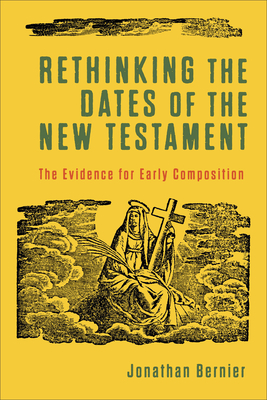What do you think?
Rate this book


318 pages, Paperback
Published May 3, 2022
When were the books of the New Testament written?
Contemporary New Testament scholars agree that Paul’s seven undisputed letters — Romans, 1 Corinthians, 2 Corinthians, Galatians, Philippians, 1 Thessalonians, and Philemon — date to the 50s. They disagree about the compositional dates of the remaining New Testament books, however.
In Rethinking the Dates of the New Testament, Jonathan Bernier identifies three chronological frameworks used by contemporary scholars: (1) “lower” chronologies date the remaining books prior to 70, (2) “middle” chronologies date them from 70–100, and (3) “higher” chronologies date them after 100.
For centuries, Christian tradition taught that the named authors of New Testament books actually wrote them, dating the books’ composition to the Apostolic Era, roughly mid- to late-first century. In Bernier’s terms, Christian tradition was a hybrid of lower and middle chronologies.
Liberal scholars, most notably Ferdinand Christian Baur, challenged this tradition in the nineteenth century, arguing that aside form Paul’s undisputed letters, the New Testament was written in the Post-Apostolic Era, well into the second century.
Today, the consensus among scholars — whether traditional or liberal — favors middle chronologies for the bulk of the New Testament.
Bernier himself makes a case for lower chronologies, arguing that the majority of New Testament books was written prior to 70, with a handful of exceptions. For the Pastoral Epistles — 1–2 Timothy and Titus — he offers a date-range of 60 ( if the letters are authentic) to 175 at the latest (if they are pseudonymous). For 2 Peter, the date range is 60 ( if authentic) to 125 (if pseudonymous). He argues that 1 and 2 John have a range from 60–100 and that 3 John is no later than 100.
He also offers date-ranges for early Christian writings outside the New Testament, including 1 Clement (64–70), Didache (60–125), Epistle of Barnabas (70–132), and Shepherd of Hermas (70–125).
Rethinking the Dates of the New Testament is the first complete scholarly monograph on the topic of the New Testament books’ dates of composition since John A. T. Robinson’s Reading the New Testament (1976), which also argued for a lower chronology.
Before Robinson, the most recent scholarly monograph to synthesize the data pertaining to the dates of New Testament books was Adolf von Harnack’s Die Chronologie der Litterateur bis Irenaeus (1897), which argued for a middle chronology but has not yet been translated into English.
Although both Robinson and Bernier argue for lower chronologies, the latter identifies “significant problems” with the work of the former: “Robinson’s tendency to approach the events of 70 [i.e., the destruction of Jerusalem] through arguments from silence”, his “Neronian error” of assuming that New Testament references to persecution must be dated to the 60s, when Nero reigned, and a “less-than-adequate attention to the method and organization of his study.”
It is on this last point, methodology, that Bernier makes his signal contribution to the chronological debate. He approaches the question as a historian, following “three fundamental steps”: “identify and define the research question, generate hypotheses that might answer the question, and adjudicate between competing hypotheses in order to determine the best answer.”
Here, the research question is when a particular book of the New Testament was written.
The hypothesis-generation step involves “basic procedures” that help historians explicate all the arguments for a range of dates. The first procedure is “synchronization,” which refers to “establishing the text’s temporal relationship to other events or situations, including the composition of other texts.” This is followed by “contextualization, which seeks to establish the text’s probable relationship to the general course of early Christian development in areas such as ecclesiology, Christology, gentile inclusion, and so on.” The final procedure is “authorial biography,” which identifies “what we know about the author and prompts us to ask when in her or his life a given text is best situated.”
Once historians have generated hypotheses, they must infer which proposed date of composition is most probable. Bernier argues that the preferable hypothesis “(1) employs the fewest number of logical fallacies, (2) can account for the greatest quantity of relevant data, and (3) can do so with the highest degree of parsimony.”
Bernier follows this methodology consistently throughout the book, showing that it can lead responsible historians to date the New Testament books earlier rather than later. He makes no appeals to tradition, authority, revelation, or miracle to sustain his arguments. And he draws no conclusions regarding the theological or apologetic implications of his work.
While the intended audience of Rethinking the Dates of the New Testament is New Testament scholars, I read the book as an ordained Christian minister and believe a wider readership may find it useful to understanding how the dates of Christian Scripture are determined. Though Bernier draws no theological or apologetic implications from his conclusions, I think lower chronologies tend to raise the historical value of the New Testament books because they shrink the timeframe between events and the writings about them.
That said, I do not agree with everything Bernier writes. For example, I am less open to pseudonymity than he is, even though he argues that most of the New Testament books are authentic. I have reservations about some of his remarks questioning Luke’s historical accuracy on certain matters. And I’m not sure he gets the details of the internal chronology of Paul’s letters right.
Even so, I recommend Rethinking the Dates of the New Testament to scholars and non-scholars alike. It is a fair-minded, methodologically rigorous treatment of the topic. And, given the fact that no similar defenses of middle and higher chronologies have been published in the last 125 years, it is the most definitive treatment currently available.
Book Reviewed
Jonathan Bernier, Rethinking the Dates of the New Testament: The Evidence for Early Composition (Grand Rapids, MI: Baker Academic, 2022).
P.S. If you liked my review, please click “Helpful” on my Amazon review page.